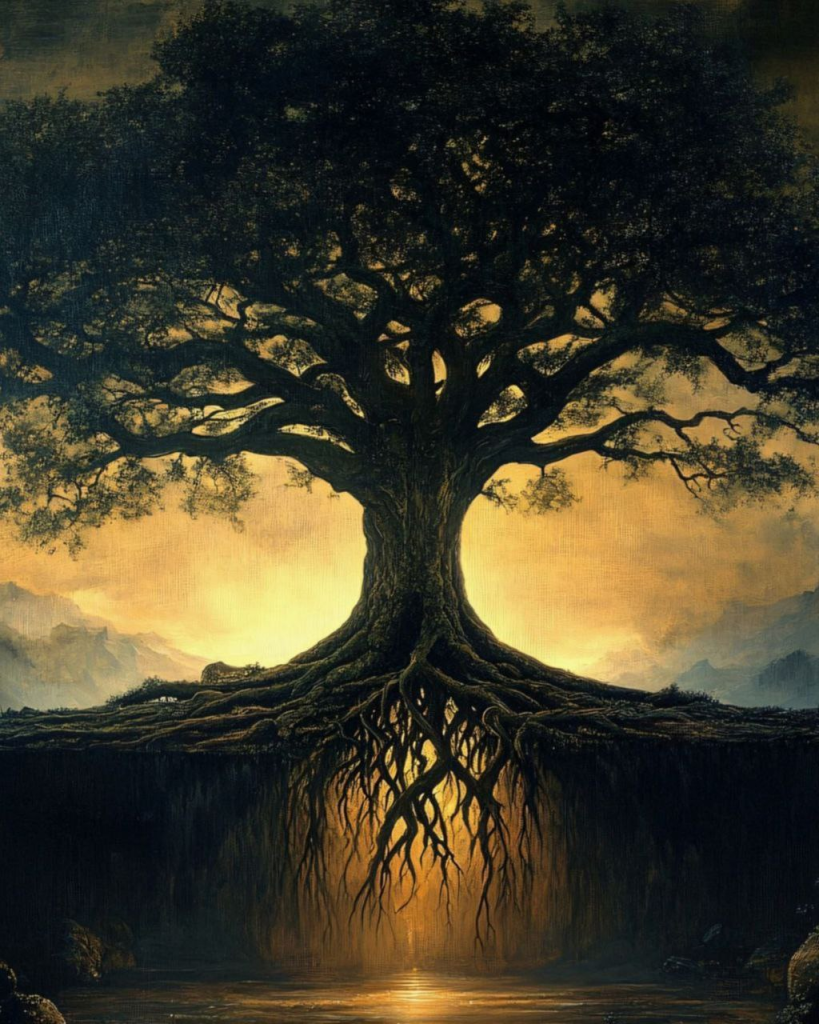
The deeply primal symbolism of the tree can only be grasped by those who can intuitively come to a direct, living experience of the tree, who are able to absorb the essence of the tree into themselves. The tree should not be analyzed with intellectual thinking, but rather we should reach the point by deepening our sensitivity that the essence of the tree confronts us as a living you, so to speak. How such an I-you relationship with a tree can take place, how it can lead to a transformation and a new unity, was once described by Martin Buber (1878-1965), the philosopher of the dialogic principle:
“With all your directed strength, receive the tree, surrender to it. Until you feel its bark like your skin and the springing of a branch from the trunk like the striving in your muscles; until your feet cling and feel like roots and your crown arches like a crown heavy with light; until you recognize your children in the blue cones; yes, truly, until you are transformed. But even in the transformation, your direction is with you, and through it you experience the tree, that you attain unity in it. (…..) It has already been planted from the earth of space into the earth of the Secle, it already speaks its secret to your heart, you already perceive the mystery of reality. Was it not a tree among trees? But now it has become the tree of eternal life.”?
The tree, this mightiest of all plants on this planet Earth, seems to be rooted as a primordial symbol deep in the collective unconscious of man. The tree of life in particular appears in almost all cultures as a symbol of cosmic unity and wholeness. “If you study the old religions,” writes Jacques Brosse, “you almost always come across cultures that have trees considered sacred at their center; the cosmic tree in particular is the object of veneration. It is the central pillar, the axis around which the universe, the natural and the supernatural, the material and the metaphysical, is organized. In the well-known mythologies, one can still discover a very archaic depth layer in which trees represent the most important means of communication between the three worlds, the subterranean abysses, the earth’s surface and the sky; in them, manifestations of the presence of gods were also expressed in a particularly clear way.”
The tree of life is not only a symbol of universal unity, but also a symbol of human wholeness. Doesn’t the tree resemble humans completely, even in its upright form? The correspondences are obvious: the tree’s roots symbolize our being rooted in the primal depths of the unconscious. The unconscious is the “ground”, that which shelters us; the “ground” in which we are rooted. The trunk of the tree, rising vertically, corresponds to the ego. Vertically, like a capital I, the ego stands on the ground of the unconscious. Finally, the treetop with all its branches and foliage symbolizes the head area of a person, their head as the seat of thought. It represents the “crowning glory” of a person, as it were. The tree of life as a cosmic universal tree, as the archetype of the universe, is reflected as the inner tree of the soul of a person.
There is a lot of talk these days about “tree death”, about the extinction of forests. One has to ask oneself whether something very crucial, essential in the soul of a person must have died in order for the great tree death of our time to have happened in the first place. The car exhaust fumes, the clouds of acid rain, the chemical toxins that destroy the forest are only the externally visible causes of forest death. The real cause of the problem, however, seems to lie deeper, namely in the fact that the inner tree of the soul of a person has obviously withered, withered, died; how can it then still develop a sense for the external natural tree?
Modern man has lost awareness of the wholeness of all existence; he is no longer part of the flow of forces of the tree of life. Therefore, human intervention in the natural balance no longer resembles sensible management of natural resources, but rather a campaign of destruction against all living things; it almost looks as if man wants to wipe out his evolutionary brothers and sisters – animals and plants – in order to remain alone on earth. At present, around 250,000 plant species and more than 1,000 species and subspecies of mammals, reptiles, birds and fish are in immediate danger of extinction, and within a short time 15 to 20 percent of all living species will probably be extinct.
Forests are particularly affected. In the so-called developing countries, in the Amazon basin or on the slopes of the Himalayas, the tropical rainforests are being cut down at a breathtaking pace. According to Aurelio Peccei, co-founder of the Club of Rome, 50 hectares of forest are cut down every minute – that is the equivalent of an annual loss of land the size of Belgium, Holland and Denmark combined. At this rate of forest destruction, the tropical rainforests, the great respiratory organ of Mother Earth, would no longer exist in about 40 years.
The feeling for the sacredness of nature, which is still quite natural for indigenous peoples close to their origins, is no longer possessed by modern civilized man. The study of sacred trees, of tree cults in Old Europe, the land of our ancestors, is therefore not an idle pastime that is carried out merely out of intellectual curiosity. Because man, as the being of the middle, should – like his relative, the tree – unite heaven and earth within himself, should be a mediator between nature and spirit, and thus encapsulate the unity of all being within himself. From a mental attitude of true connection to the cosmos, true “religio” in the sense of connection to the whole, man can turn lovingly to all natural beings: plants, animals and trees alike. He would then develop a new feeling for the higher consecration of nature that it deserves as a spiritually created organism.
Sacred Trees: Tree Cults in Ancient Europe
h/t Huter der Irminsul



Roth, you and I both being of the old ways have an understanding and appreciation for trees that most will never understand.
I am thankful for trees. I have been going through firewood like water
You and me both, brother!
Me three! and I’m in the “warmer” part of Oregon.
We’re burning a lot of wood as well.
I also hope to see the tree of Liberty be used stretch a few necks as well.
Colossians 2:8
Poems are wrote by fools like me, but only God can make a tree,